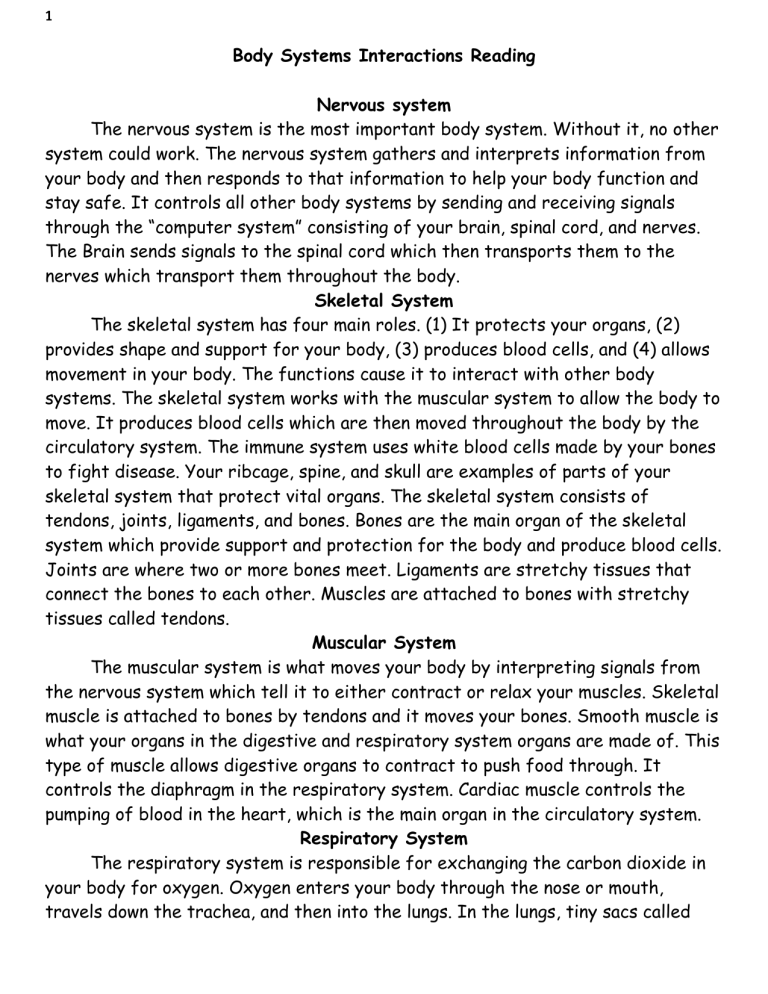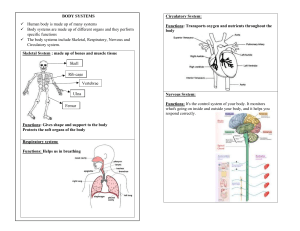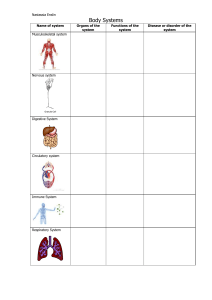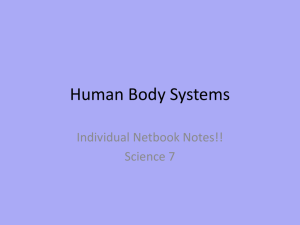
1 Body Systems Interactions Reading Nervous system The nervous system is the most important body system. Without it, no other system could work. The nervous system gathers and interprets information from your body and then responds to that information to help your body function and stay safe. It controls all other body systems by sending and receiving signals through the “computer system” consisting of your brain, spinal cord, and nerves. The Brain sends signals to the spinal cord which then transports them to the nerves which transport them throughout the body. Skeletal System The skeletal system has four main roles. (1) It protects your organs, (2) provides shape and support for your body, (3) produces blood cells, and (4) allows movement in your body. The functions cause it to interact with other body systems. The skeletal system works with the muscular system to allow the body to move. It produces blood cells which are then moved throughout the body by the circulatory system. The immune system uses white blood cells made by your bones to fight disease. Your ribcage, spine, and skull are examples of parts of your skeletal system that protect vital organs. The skeletal system consists of tendons, joints, ligaments, and bones. Bones are the main organ of the skeletal system which provide support and protection for the body and produce blood cells. Joints are where two or more bones meet. Ligaments are stretchy tissues that connect the bones to each other. Muscles are attached to bones with stretchy tissues called tendons. Muscular System The muscular system is what moves your body by interpreting signals from the nervous system which tell it to either contract or relax your muscles. Skeletal muscle is attached to bones by tendons and it moves your bones. Smooth muscle is what your organs in the digestive and respiratory system organs are made of. This type of muscle allows digestive organs to contract to push food through. It controls the diaphragm in the respiratory system. Cardiac muscle controls the pumping of blood in the heart, which is the main organ in the circulatory system. Respiratory System The respiratory system is responsible for exchanging the carbon dioxide in your body for oxygen. Oxygen enters your body through the nose or mouth, travels down the trachea, and then into the lungs. In the lungs, tiny sacs called 2 alveoli, a small part of the respiratory system with a big job, works with the circulatory system to put the oxygen into the blood vessels of the circulatory system. The arteries take the oxygen rich blood to all parts of the body. When that oxygen has been dropped off in the body, the veins bring the blood back up to the lungs to drop off the carbon dioxide for disposal and to get more oxygen. Because the respiratory system removes carbon dioxide waste from the body, it functions as part of the excretory system as well. The muscle that makes this entire system work is called the diaphragm. The diaphragm is an involuntary muscle controlled by the nervous system. Circulatory System The circulatory system is like the highways system of the body. The heart pumps blood through the blood vessels, which transport materials all over the body. There are three types of blood vessels: arteries, veins, and capillaries. Arteries take oxygen rich blood away from the heart and to the rest of the body. Nutrients are picked up along the way and oxygen is dropped off as blood circulates through the body. After arteries drop off the oxygen, tiny blood vessels called capillaries connect the arteries to veins, which take the oxygen poor blood back to the heart to be re-oxygenated and sent back through the body. As mentioned before, the circulatory system works closely with the respiratory system. It also works with the digestive system. When your small intestine removes nutrients from your food, the blood vessels absorb and deliver these digested nutrients to cells all over the body so they can be used. In addition to circulating gases and nutrients through the body, the circulatory system also moves white blood cells, used by the immune system to fight disease. The kidneys, part of the excretory system, filter and clean the waste and toxins from the blood as it travels to and from the heart. Finally, the muscle behind this whole operation, the heart, is controlled by the nervous system. Digestive System The digestive system’s job is to take in food, digest it into smaller molecules, and absorb the nutrients from it. Then, it functions as part of the excretory system by removing the leftover, indigestible food waste (feces) from the body. The whole process starts in the mouth, where food is mechanically digested (physically broken down) by your teeth. Next, it is swallowed and travels down the esophagus, a smooth muscle, which involuntarily contracts to move the food into the stomach. In the stomach, there is stomach acid which chemically breaks down the food even more and destroys some pathogens which may harm the body. After 3 food leaves the stomach, it enters the small intestine which removes the nutrients, through facilitated diffusion, where are absorbed into the circulatory system for shipment throughout the body. Finally, the water is removed from the leftover waste in the large intestine through the process of osmosis and the food exits the body by way of the rectum and anus. Excretory System The excretory system is the clean-up crew of the body. It consists of parts of many different body systems which work together to remove waste products from the body. The circulatory system works with the respiratory system to remove carbon dioxide waste from the body, specifically, the lungs use passive transport, more specifically diffusion, to remove carbon dioxide from the body.The urinary system filters waste from the circulatory system when blood flows through the kidneys. After the waste has been filtered from the blood in the kidneys, it goes down the ureters (tubes that connect the kidneys to the bladder) and into the bladder to be stored until the body is ready to expel it. It then exits the body through the urethra. The integumentary system sweats to remove excess water, salt, and toxins through the skin. Finally, the digestive system removes solid, food waste from the body through the large intestine. Integumentary System The integumentary system, which consists of your skin, hair, and nails, works with the immune system by serving as the first line of defense against disease and pathogens. It helps to maintain homeostasis and remove waste from the body (excretory system) by sweating. The nervous system works with the integumentary system by causing sweating or goosebumps in order to maintain a stable internal temperature (homeostasis). Immune System The immune system is the only system whose main job is to fight disease in the body. However, several other systems work with it to help protect the body from disease. The circulatory system transports white blood cells to fight pathogens. The lymphatic system has a lot of white blood cells to fight disease and the lymph nodes filter pathogens. The skeletal system is where the blood cells are produced, in the part of the bone called the marrow.



